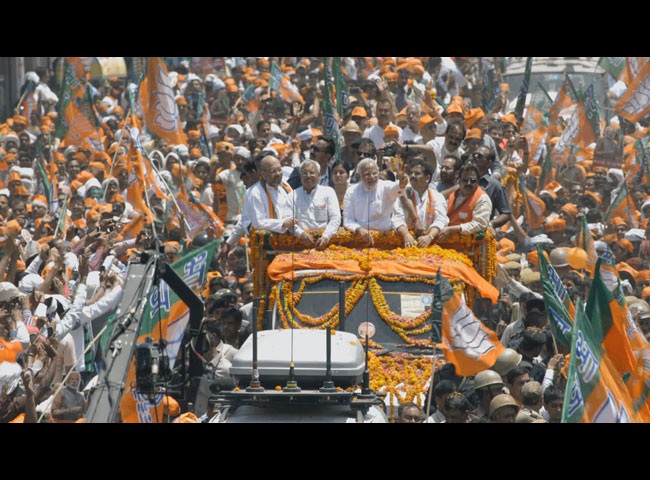The Battle for Banaras
-
Réalisé par Kamal Swaroop • Écrit par Kamal Swaroop
-
Inde • 2015 • 133 minutes • Couleur
- Réalisation :
Kamal Swaroop - Écriture :
Kamal Swaroop - Image :
Riju Das - Son :
Gautam Nair - Montage :
Shweta Rai
- Production (structure) :
Mediente International Films - Ayant droit :
Mediente International Films
- N° ISAN :
non renseigné
Résumé
Pendant la campagne des législatives de mai 2014, meetings et manifestations agitent les rues de la ville sainte de Bénarès. Le candidat favori n’est autre que le futur Premier ministre indien, Narendra Modi (du parti de droite BJP), dont le principal opposant est Arvind Kejriwal, du jeune parti AAP. Kamal Swaroop cale son ambition sur l’ampleur des mouvements de foule : il ne s’agit pas ici de documenter une élection-tsunami mais d’interroger, à travers elle, le fonctionnement de la plus grande démocratie d’Asie. En contrepoint des séquences de rue, les discussions du cinéaste avec un ami apportent des éclaircissements sur la poli- tique indienne. Mais même pendant leurs échanges, la vie bat son plein à l’arrière-plan, les bûchers funéraires sont érigés au bord du Gange, la fête de Shiva se prépare, la manufacture de statuettes fonctionne à plein. Cette fébrilité produc- tive est aussi à l’œuvre dans les discours et dans l’empressement des reporters à micro. Jamais partisan, Battle for Banaras transmet cependant le sentiment diffus, parfois proféré par des pas- sants politisés, que les partis sont corrompus, la religion asservie par les politiciens, bref, comme dit un tisserand, que "les cerveaux ont cessé de fonctionner". Ce film a été interdit par le Comité de censure indien, qui l’a qualifié d’"incendiaire". (C.G.)
During the May 2014 election campaign, rallies and demonstrations fill the streets of the holy city of Banaras. The frontrunner is none other than the Prime Minister-to-be, Narendra Modi (from the right-wing BJP party), and opposing him Arvind Kejriwal from the young AAP party. Kamal Swaroop cues his ambition on the vastness of the movements of crowds, which does not mean documenting a tsunami-like election, but using this to question the working of Asia’s largest democracy. In counterpoint to the street sequences, the filmmaker’s discussions with a friend shed light on Indian politics. But even during these exchanges, life is in full swing in the background, funeral pyres are being built on the banks of the Ganges, the Shiva festival is under preparation, the statuette-makers are producing at full capacity. This productive feverishness also drives the speeches and the eagerness of the reporters with their microphones. Never biased, Battle for Banaras nonetheless conveys the vague feeling – sometimes voiced by politically aware passers-by – that the parties are corrupt, that religion is enslaved to politicians, in short, as one textile worker says, that “brains have stopped functioning”. The film was banned by the Indian Censor Board, which described it as inflammatory. (C.G.)
Mot(s)-clé(s) thématique(s)
Sélections et distinctions
- 2016 • Cinéma du réel • Paris (France) • Compétition internationale
Comment avoir accès au film ?
-
Édition DVD
- Il n'existe pas d'édition DVD à notre connaissance
-
Accès VOD
- Il n'existe pas d'accès en VOD à notre connaissance
- Distribution
- Aide sur les moyens d'accéder à un film
